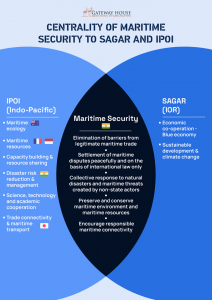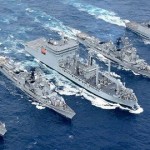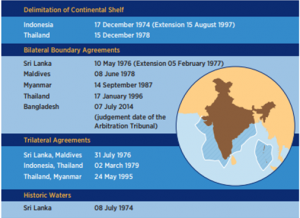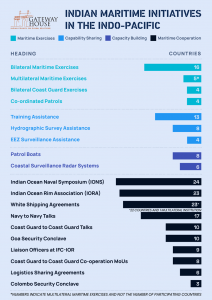Introduction
India’s early support for the Indo-Pacific construct is a natural extension of its approach in the Indian Ocean Region (IOR), which expands regional policies like “Neighbourhood First” and “Act East” (formerly Look East) to the entire geo-strategic and economic region that connects the two oceans. India’s maritime security strategy in the IOR thus points to its agenda in the larger Indo-Pacific region.
India has always regarded the seas as important for trade and connectivity. 90% of the country’s trade by volume and almost all its oil imports come via the ocean. Unsurprisingly, prior to 2008, New Delhi’s maritime security strategy predominantly focused on safeguarding Sea Lines of Communications (SLOCs) and Humanitarian Assistance and Disaster Relief (HADR) operations. Since independence, India’s growth as a maritime power was largely overshadowed by terrestrial security threats. Notwithstanding a continental security mindset and frequent landward military encounters with Pakistan and China, the Indian Navy has continued to grow at a modest pace in both capacity and capabilities to operate farther away from its shores. However, since then, India has increasingly envisioned itself as a Net Security Provider to the island nations in the region.[1]
India’s Evolving Maritime Security Strategy
Three distinct events have shaped India’s maritime security outlook within the IOR. These include:
- Terror strikes from sea
The 26/11 terrorist attacks in Mumbai in 2008 led India’s national security establishment to overhaul traditional maritime security mechanisms and responses. The Indian Navy was entrusted with the responsibility of overall maritime security, including coastal and offshore security.
- Maritime Piracy
The rise of piracy and armed robbery in the past decade has posed a significant threat to international shipping and seafarers – a particular concern for India since it accounts for the second-highest number of seafarers in the world. The recent spate of attacks on merchant vessels by non-state actors has only enhanced the need for greater presence by maritime law enforcement agencies. Since October 2008, the Indian Navy has maintained a ship on continuous patrol in the Gulf of Aden. While piracy is a real concern, it also is a convenient justification for countries interested in increasing their military presence in the Indian and Pacific regions. Indeed, many of the 44 countries, including China, that have deployed naval forces in the Indian Ocean and have cited piracy as the reason.
- Growing Chinese presence in IOR
Since 2008, China has projected a near permanent presence in the IOR. China’s Belt and Road Initiative and its allied Maritime Silk Route initiatives, though economic, have obvious geopolitical purposes. Since their inception, India is the only major power that has consistently opposed them, citing concerns that involve sovereignty, financing standards, project sustainability and transparency.[2] At the August 2021 debate on maritime security at the UN Security Council, PM Narendra Modi emphasized[3] the importance of physical sustainability and absorption capacity of the host countries and the need for global norms and standards.
Meanwhile, China has stationed a task force of three ships in the Gulf of Aden for anti-piracy operations. It docked a submarine in 2014 at Colombo port,[4] opened a military base in Djibouti, and acquired 99-year lease rights over Hambantota port in 2017.
In the last five years, China’s Navy has added more than 90 major combatant platforms and is expected to grow to 400 ships by 2025.[5] In pursuit of its stated goal to transform its mission from “defense of near seas to protection missions in the far seas,”[6] PLA Navy ships have made 20 port visits in IOR every year[7] since 2010. Under its current force posture, the PLA Navy is capable of maintaining 18 ships in the region.[8]
China also has increased infrastructure investments in the region through its signature Belt and Road and Maritime Silk Route initiatives. Increased military and economic engagement in the IOR are crucial to China’s growing influence on established regional orders and alignments.
Maritime Security Challenges in IOR
Maritime security issues in the West Pacific Ocean are centered around territorial maritime disputes, whereas non-traditional security threats take precedence within the IOR. This difference was on full display at the 9th August 2021 open debate on Enhancing Maritime Security: A Case for International Cooperation,[9] as regional powers focused more on “non-traditional” threats like piracy, over-fishing, human and arms trafficking, narcotic smuggling and climate change, while Western nations focused on “traditional” threats posed by state actors like China, Russia and Iran. India presided over the event.
India’s Approach to Maritime Security
India is a founding member of the Indian Ocean Rim Association (IORA), which was established in 1997. Traditionally, the IORA focused on enhancing economic cooperation and did not include maritime security as a focus area. In 2011, when India held the IORA chair, maritime safety and security was identified as a key focus area for the forum.[10]
Subsequently, Security and Growth for All in the Region (SAGAR), which was espoused in March 2015,[11] and the Indo-Pacific Oceans Initiative (IPOI),[12] which was announced by Prime Minister Narendra Modi at the November 2019 East Asia Summit, have become India’s holistic strategies for IOR and the larger Indo-Pacific. Both strategies identify maritime security as a fundamental pre-requisite for a safe, secure, stable and prosperous maritime domain. Amplifying India’s strategy on maritime security, India in August 2021 set forth at the UN Security Council five principles[13] for creating broad-based convergence on maritime security.

Fig 1 – Centrality of Maritime Security Strategy to India’s SAGAR and IPOI
Source – Gateway House Research
India has rightfully taken leadership of two of the seven IPOI pillars – Maritime Security and Disaster Risk Reduction and Management.[14] Key elements of the proposed Maritime Security pillar include: elimination of barriers to legitimate maritime trade, peaceful settlement of disputes, response to natural disasters and threats from non-state actors, maritime environment, and maritime connectivity.
- Elimination of barriers to legitimate maritime trade
Free-flow of maritime trade is crucial to global prosperity. India, in particular, relies overwhelmingly on the seas for its external trade and for meeting its energy needs. The Indian Ocean is host to some of the busiest maritime transportation links, representing about half of the world’s container traffic, one-third of world’s bulk cargo and two-thirds of oil shipments. The fact that three quarters of this traffic heads to destinations beyond IOR underscores the vitality of India’s role in ensuring free-flow of maritime trade through the region’s International Shipping Lanes (ISLs).
Piracy has emerged as the primary threat to legitimate maritime trade. Since 2008, the India has been an active member of the 60-country Contact Group on Piracy off the coast of Somalia. The Indian Navy has deputed ships on more than 84 occasions[15] for anti-piracy operations and has thwarted more than 50 piracy attacks.
Since its inception in 2006, India has been a contracting party to the Singapore-based Regional Cooperation Agreement on Combating Piracy and Armed Robbery against Ships in Asia (ReCAAP). In September 2020, India also joined the Djibouti Code of Conduct/Jeddah Amendment as an observer;[16] the code provides a basis for co-operation against piracy and armed robbery. In recognition of the need for greater collaboration, India and EU Naval Forces held a maiden anti-piracy exercise[17] in the Gulf of Aden in June 2021. These efforts reflected India’s leadership and multi-aligned approach for protecting trade flows.
- Peaceful settlement of maritime disputes on basis of international law
India has been a responsible and law-abiding member of the rules-based international order. It has adopted a dialogue-based approach to resolving maritime disputes with its neighbors without wielding its military might. When a dialogue-based approach has failed, India has accepted and abided by rulings of the Arbitration Tribunal, as it did in 2014 to resolve maritime disputes with Bangladesh.[18] India ceded to Bangladesh 19,467 square kilometers of a 25,602 square kilometer contested sea area in the Bay of Bengal. In continuation of its track-record, in May 2019, India voted in favor of Mauritius on the UN General Assembly resolution that demanded the withdrawal of the United Kingdom’s “colonial administration” from the Chagos Archipelago.
Table 1 – Settlement of India’s Maritime Boundaries
Source – Ensuring Secure Seas: Indian Maritime Security Strategy[19]
- Collective response to natural disasters and maritime threats created by non-state actors
India has established itself as a first responder[20] for Humanitarian Assistance and Disaster Relief (HADR) in the IOR.[21] On maritime threats emanating from non-state actors, establishing maritime domain awareness and sustained operational presence is key. While the Indian Coast Guard (ICG) is the primary maritime law enforcement agency in the Indian Exclusive Economic Zone (EEZ), the Indian Navy has increased its maritime presence in the IOR beyond its EEZ. Since 2017, the Indian Navy mission-based deployments[22] have facilitated enhanced Maritime Domain Awareness (MDA) and have provided swift HADR to the Indian Ocean Region littorals and security to the international maritime community. Additionally, India has concluded White Shipping agreements with 22 countries, and set-up the Information Fusion Centre-Indian Ocean Region (IFC-IOR) in December 2018, which now hosts liaison officers from seven countries. IFC-IOR has secured White Shipping agreements with multiple countries in the region and aims to build confidence and capacity amongst partner nations, thereby ensuring swift and accurate exchange of information for comprehensive, real-time and shared MDA.
The Indian Ocean Naval Symposium (IONS), conceived by the Indian Navy, seeks to enhance maritime cooperation among Navies of the littoral states of the IOR by providing an open and inclusive forum for discussion of regionally relevant maritime issues. The 24-member forum also includes Pakistan, showing that India’s maritime security strategy transcends political considerations and is based on building collective maritime security capabilities. In continued pursuit of the collective ethos, in February 2021, India held the first IOR Defense Minister’s conclave in Bengaluru; 26 of 28 countries in the IOR participated.[24]
- Preservation of maritime environment and resources
India is a member of the Indian Ocean Tuna Commission, which was established in 1993 to promote co-operation on management, conservation and utilization of fish stocks in the region.
Closer to the Indian coast, the ICG is responsible for preservation and protection of the marine environment and control of marine pollution. Identifying the need for wider multinational co-operation to preserve the maritime environment and resources, the Indian Coast Guard has been an active member of the Heads of Asian Coast Guard Agencies Meeting (HACGAM) – a forum that focuses on search and rescue, environmental protection, prevention and control of unlawful acts at sea, and capacity building.
In April 2021, Australia joined India to co-lead the Marine Ecology pillar of the IPOI, which seeks to drive scientific collaboration and share best practice on reducing marine pollution across the Indo-Pacific, with a focus on plastic waste.[25] In the same month, India also joined a partnership between Norway, the International Maritime Organization (IMO) and the Food and Agriculture Organization (FAO) as one of the ten Lead Partnering Countries (LPCs).[26] The LPCs will take prime roles in their respective regions to champion national actions in support of the IMO Action Plan on Marine Litter. The partnership is led by GloLitter Partnerships (GLP). [27]
- Responsible maritime connectivity
India has been an active player in ushering responsible maritime connectivity in its neighborhood. It has been a part of maritime logistics projects in Sri Lanka, Maldives, Mauritius and Seychelles. India is also working with Myanmar on the Kaladan transport project, which improves trade links to Sittwe port in Myanmar. India also has entered into an agreement with Indonesia to develop a strategic port at Sabang,[28] which lies at the tip of Sumatra Island close to the Malacca Strait. In March 2020, India joined the five-island nation’s Indian Ocean Commission (IOC) as an observer;[29] the commission focuses on sustainable development.
In 2019-20, India provided about 1.03 billion US dollars as grants,[30] most of which went to countries in the IOR. China, on the other hand, is estimated to have doled out 5.9 billion US dollars[31] as grants during the same period. India has therefore relied on Japan and, more recently, with the EU to provide alternate financing options for regional maritime partners. Japan joined India’s IPOI as the lead partner for connectivity in Oct 2020.[32] In May 2021, India and EU launched the Connectivity Partnership,[33] which identified joint support for sustainable connectivity in third countries and regions as one of its key focus areas. Later, in June 2021, India joined the first India-Japan-Italy trilateral[34] discussions on the Indo-Pacific, which focused on maritime connectivity amongst other issues in the Indo-Pacific.
Conclusion
India has an established IOR maritime security strategy that focuses on regional prosperity through collective management of non-traditional threats. Such a strategy is in line with India’s rise as a peaceful maritime power and the aspirations of regional partners. Its first instinct will be to extend its this strategy, including its primarily focus on non-traditional maritime threats, to the larger Indo-Pacific region. Strengthening capacity and capabilities in the maritime domain is now considered a vital element in India’s Comprehensive National Power.
This suggests that India is likely to adopt a two-pronged strategy for maritime security, relying on multi-aligned partnerships for non-traditional maritime security threats in the Indo-Pacific and the Quadrilateral Security Dialogue (“Quad”), a partnership among the United States, Japan, Australia and India, for both traditional as well as non-traditional threats.
Fig 2 – Indian Maritime Initiatives in the Indo-Pacific
Source – Gateway House Research
Great-power competition in the Indo-Pacific is a cause of concern for regional powers. India has adapted to this geo-political change, and is consciously moving away from its traditional non-aligned approach to a multi-aligned one. Speaking at the 21st IISS Fullerton Lecture in Singapore in 2015, then-Foreign Secretary Dr S Jaishankar stated that India aspires to be a leading power, rather than just a balancing power, and thus is increasingly willing to shoulder greater global responsibilities.[35]
Trilateral formats, including India-Australia-Japan, India-Australia-France, India-Japan-Italy, India-Australia-Indonesia, and India-Sri Lanka-Maldives,[36] as well as the Forum for India–Pacific Island Cooperation (FIPIC), reflect India’s attempts to build regional frameworks that exist outside great-power competition. Such collaborative formats are likely to find greater acceptance in a region increasingly shadowed by great power competition.
India is a near, yet non-resident power in the Pacific. It acknowledges that a safe, secure and stable maritime space in the Indo-Pacific is a necessary condition for peace, security and prosperity, and disputes over ownership and rights pose a security challenge.[37]. The Quad seems to be India’s primary instrument to counter traditional maritime security threats as it seeks to expand its influence and role beyond the IOR. In March 2021, India signed the joint Quad Leader’s statement, which explicitly cited the need for cooperation in overcoming challenges to the rules-based maritime order in the East and South China Seas.[38]
Since 2010, India has sent more than 40 warships to South China Sea, averaging four warships a year. India has also significantly increased the number of bilateral maritime exercises with nations in the Indo-Pacific. The reciprocal logistics agreements signed by India with six nations are not one-sided. India not only hopes to enhance capabilities of maritime partners, but also expects to utilize these agreements to further bolster its maritime presence beyond IOR and into the Pacific. The fact that India welcomed the September 2020 U.S.-Maldives Defense Agreement[39] is a sign of India’s increasing strategic alignment with the U.S. and a broader strategy adopted by many regional powers to dilute Chinese influence.[40]
Despite being the largest Navy in the IOR, the Indian Navy is increasingly identified as a stabilizing force in the IOR and the larger Indo-Pacific. Going forward, India’s maritime security strategy in the Indo-Pacific will strive to strike a balance between its own articulation of Collective Maritime Security[41] focused on non-traditional threats and the U.S.-led Integrated Deterrence[42] focused on traditional threats in the maritime domain.
Commander (Rtd.) Amrut Godbole, Former Fellow, Indian Navy Studies, Gateway House.
This paper has been published by Gateway House, with the support of the United States Embassy, New Delhi. Read the full compendium ‘India in the Indo-Pacific: Pursuing Prosperity and Security’ here.
The views and opinions expressed in this paper are solely those of the authors. The views expressed in the paper do not necessarily reflect those of the United States Embassy, New Delhi.
For interview requests with the authors, or for permission to republish, please contact outreach@gatewayhouse.in.
© Copyright 2022 Gateway House: Indian Council on Global Relations. All rights reserved. Any unauthorized copying or reproduction is strictly prohibited.
References:
[1] http://www.pibmumbai.gov.in/scripts/detail.asp?releaseId=E2011PR1583
[2] https://mea.gov.in/media-briefings.htm?dtl/28463/Official+Spokespersons+response+to+a+query+on+participation+of+India+in+OBORBRI+Forum
[3] https://www.mea.gov.in/Speeches-Statements.htm?dtl/34151/English_translation_of_Prime_Ministers_remarks_at_the_UNSC_HighLevel_Open_Debate_on_Enhancing_Maritime_Security_A_Case_For_International_Cooperation_A
[4] https://www.mea.gov.in/rajya-sabha.htm?dtl/24359/Q+NO+516+CHINESE+SUBMARINES+DOCKED+IN+SRI+LANKAN+PORT
[5] China Naval Modernization: Implications for U.S. Navy Capabilities—Background and Issues for Congress, August 2021, available at: https://fas.org/sgp/crs/row/RL33153.pdf
[6] China’s National Defense in the New Era, July 2019, Available at: https://www.andrewerickson.com/2019/07/full-text-of-defense-white-paper-chinas-national-defense-in-the-new-era-english-chinese-versions/
[7] Chinese Military Diplomacy, 2003–2016: Trends and Implications, Kenneth Allen, Phillip C. Saunders, and John Chen, Available at :
[8] China Maritime Report China Maritime Report No. 11: Securing China t No. 11: Securing China’s Lifelines across the Indian Ocean, Jeffrey Becker, available at : https://digital-commons.usnwc.edu/cgi/viewcontent.cgi?article=1010&context=cmsi-maritime-reports
[9] https://pib.gov.in/PressReleasePage.aspx?PRID=1743814
[10] https://www.mea.gov.in/Portal/ForeignRelation/IORA_new.pdf\
[11] https://www.mea.gov.in/Speeches-Statements.htm?dtl/24912/Prime_Ministers_Remarks_at_the_Commissioning_of_Offshore_Patrol_Vessel_OPV_Barracuda_in_Mauritius_March_12_2015
[12] https://www.mea.gov.in/Speeches-Statements.htm?dtl/32171/Prime_Ministers_Speech_at_the_East_Asia_Summit_04_November_2019
[13] https://www.mea.gov.in/Speeches-Statements.htm?dtl/34151/English_translation_of_Prime_Ministers_remarks_at_the_UNSC_HighLevel_Open_Debate_on_Enhancing_Maritime_Security_A_Case_For_International_Cooperation_A
[14] https://www.eoimanila.gov.in/speeches_detail/?id=22
[15] Opening Remarks by Chief of the Naval Staff, Admiral Karambir Singh during the Annual Navy Day press conference on December 3, 2020, Available at : http://www.spsnavalforces.com/story/?id=702&h=andldquo;We-remain-committed-to-the-vision-of-andlsquo;Make-in-Indiaandrsquo;-and-andlsquo;AtmaNirbharataandrsquo;-in-the-Defence-Sectorandrdquo;
[16] https://www.mea.gov.in/press-releases.htm?dtl/32977/India+joins+the+Djibouti+Code+of+Conduct+as+Observer
[17] https://eeas.europa.eu/headquarters/headquarters-homepage/100358/eu-india-joint-naval-exercise_en
[18] https://www.pcacases.com/web/sendAttach/383
[19] https://www.indiannavy.nic.in/sites/default/files/Indian_Maritime_Security_Strategy_Document_25Jan16.pdf
[20] https://www.mea.gov.in/Portal/IndiaArticleAll/636548962666860480_Responding_First_Leading_Power.pdf
[21] After the 2004 tsunami, India deployed 14 Navy vessels, nearly 1,000 military personnel and several dozen helicopters and airplanes to Sri Lanka. In 2007, in the aftermath of cyclone Sidr, India was one of the few countries allowed to provide relief to Myanmar, sending critical rice supplies to address food emergencies there. In 2014, the Indian Navy was the first to arrive in the Maldives to provide fresh drinking water to more than 150,000 of its citizens facing an acute supply crisis. More recently, in response to Cyclone More (2017), India was the first nation to respond to the devastating floods in Sri Lanka and Bangladesh. As reflected in relief provided to Pakistan in 2005 and 2010, Indian support is driven by a deep humanitarian drive that transcends political considerations. More recently, Mission Sagar, launched on 10 May 2020, was India’s initiative to deliver Covid 19-related assistance to the countries in the Indian Ocean Region. The Indian Navy successively delivered assistance to maritime neighbours Maldives, Mauritius, Madagascar, Comoros and Seychelles in dealing with the Covid crisis. Mission Sagar was later extended to Sudan (November 2020), Vietnam and Cambodia (both in December 2020) and Vietnam, Indonesia and Sri Lanka (August 2021)
[22] https://pib.gov.in/PressReleasePage.aspx?PRID=1646978
[23] https://www.newindianexpress.com/nation/2018/apr/01/indian-navy-informs-government-about-the-fleets-reoriented-mission-pattern-1795404.html
[24] https://pib.gov.in/PressReleasePage.aspx?PRID=1695120
[25] https://india.highcommission.gov.au/ndli/AIIPOIP.html
[26] https://www.imo.org/en/MediaCentre/PressBriefings/pages/GloLitter-Project-30-countries.aspx
[27] https://www.imo.org/en/MediaCentre/HotTopics/Pages/marinelitter-default.aspx
[28] https://www.mea.gov.in/distinguished-lectures-detail.htm?840
[29] https://www.commissionoceanindien.org/presentation-coi/membres-observateurs-coi/
[30] https://www.indiabudget.gov.in/doc/eb/vol1.pdf
[31] https://www.jica.go.jp/jica-ri/publication/other/l75nbg000019o0pq-att/Estimating_Chinas_Foreign_Aid_2019-2020.pdf
[32] https://mea.gov.in/press-releases.htm?dtl/33100/13th_IndiaJapan_Foreign_Ministers_Strategic_Dialogue
[33] https://mea.gov.in/bilateral-documents.htm?dtl/33854/IndiaEU_Connectivity_Partnership
[34] https://mea.gov.in/Speeches-Statements.htm?dtl/33924/Secretary_Easts_opening_remarks_at_the_IndiaJapanItaly_Trilateral_Webinar_on_IndoPacific_June_17_2021
[35] https://mea.gov.in/Speeches-Statements.htm?dtl/25493/IISS_Fullerton_Lecture_by_Foreign_Secretary_in_Singapore
[36] https://www.hcicolombo.gov.in/press?id=eyJpdiI6IlwvTnkrakdXZVdqZlAyXC93ajZoSVc0dz09IiwidmFsdWUiOiIwRmhwMU5nR0lzanVOdGRwNG5GZ2ZBPT0iLCJtYWMiOiIxNGI0ZGJlZTc1NmQ5OWQ3NzQ0ODg1ZGU4YzllMTAzMzk0MThiZDU4MzZlMGI5NTQzNzI4MzQxYzcxMTVmZjI1In0=
[37] https://mea.gov.in/Speeches-Statements.htm?dtl/33309
[38] https://mea.gov.in/bilateral-documents.htm?dtl/33620/Quad+Leaders+Joint+Statement+The+Spirit+of+the+Quad
[39] https://www.defense.gov/Newsroom/Releases/Release/Article/2344512/the-maldives-and-us-sign-defense-agreement/
[40] https://nsc.crawford.anu.edu.au/sites/default/files/publication/nsc_crawford_anu_edu_au/2019-08/ap14-3-medcalf-july2019.pdf
[41] https://pib.gov.in/Pressreleaseshare.aspx?PRID=1695245
[42] https://www.defense.gov/Newsroom/Transcripts/Transcript/Article/2711025/secretary-of-defense-lloyd-j-austin-iii-participates-in-fullerton-lecture-serie/




